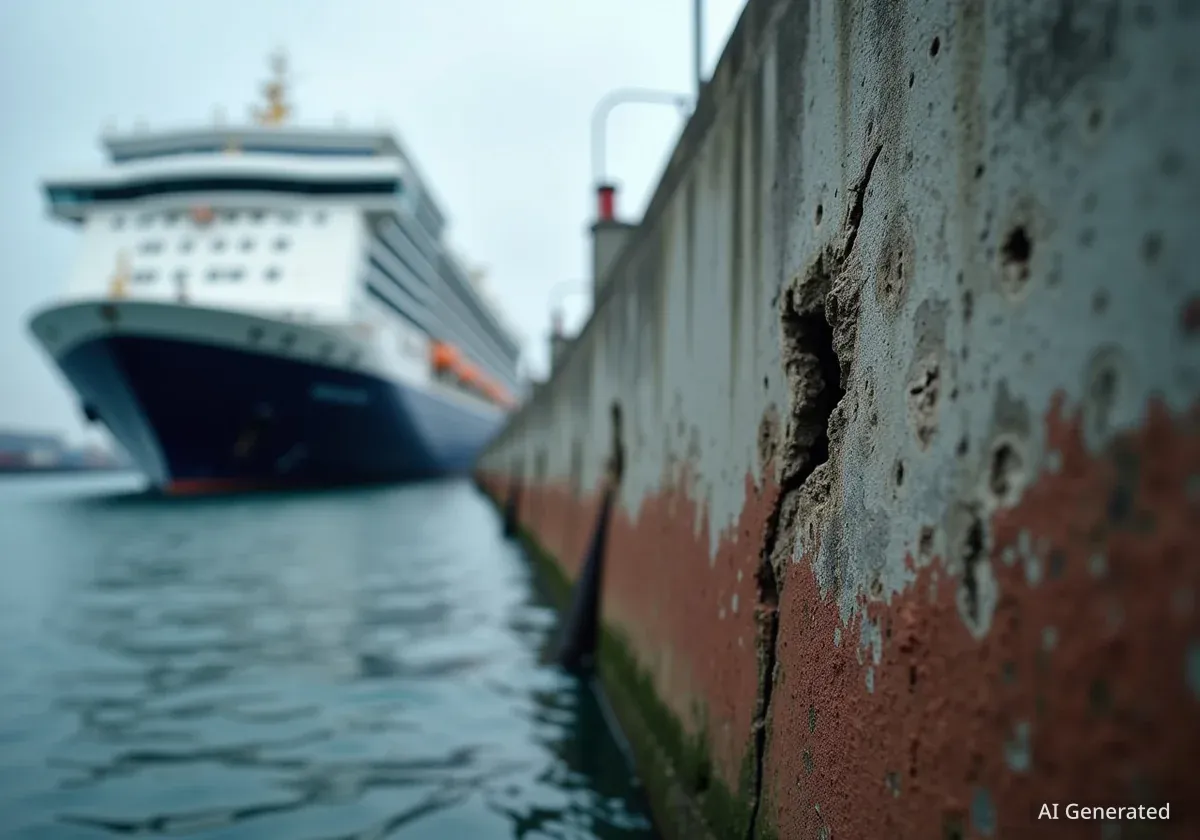The new Isle of Man ferry terminal in Liverpool, which opened in June 2024, is scheduled for repairs in November after a crucial protective device was damaged during berthing trials last winter. The Isle of Man Steam Packet Company has confirmed the work will cause temporary disruption to services, with some sailings being rerouted.
The issue involves a "dolphin fender," a cushioning device designed to protect vessels at the berth. It was found to clash with mooring lines at low tide, impacting the new Manxman ferry and the Ben-my-Chree. This has prompted a two-phase repair plan and led to legal negotiations over what has been described as a design flaw from the project's early stages.
Key Takeaways
- Repairs are scheduled for the new Isle of Man ferry terminal in Liverpool in early November.
- A protective "dolphin fender" was damaged during berthing trials, clashing with mooring lines at low tide.
- The issue affects the Manxman and Ben-my-Chree vessels, but not the fast-craft Manannan.
- Sailings on November 1 and 2 will be diverted to Heysham, with coach transfers provided for passengers.
- The Isle of Man government is in legal negotiations with designers over the original design, which is cited as the root cause of the problem.
Details of the Required Repairs
The core of the problem lies with a specific piece of port infrastructure known as a dolphin fender. This component is essential for safe mooring, acting as a large protective cushion between the ferry and the concrete berth structure. According to the Steam Packet Company, this fender "clashed with mooring lines" during trials conducted at low tide last winter.
This interference creates operational challenges, particularly for the fleet's larger conventional ferries. Michelle Haywood, the Isle of Man's Infrastructure Minister, explained the immediate need for action. She stated the fender is currently "stopping Manxman mooring sensibly," necessitating its removal as the first step in the repair process.
The repair work is planned in two distinct phases. The initial phase, set for November, will involve lifting the damaged fender out of the way to allow the Manxman to dock safely throughout the winter season. This is a critical short-term solution to ensure service continuity.
Why the Delay in Repairs?
Although the damage occurred last winter, repairs could not be undertaken sooner. The delay is attributed to the operational schedule at the new terminal. The fast-craft ferry, Manannan, which is unaffected by the fender issue, has been using the berth daily throughout the busy spring and summer seasons.
Minister Haywood noted that this left a "restricted window" for contractors to access the site and perform the complex repairs. The upcoming winter schedule, with fewer daily sailings, provides the first viable opportunity to address the problem without causing prolonged daily disruption to the vital sea link.
The New Liverpool Ferry Terminal
The Isle of Man Ferry Terminal at Princes Half Tide Dock is a significant investment for the Isle of Man government. It represents the largest capital project ever undertaken by the government on UK soil. The facility officially opened in June 2024, aiming to provide modern and improved facilities for passengers traveling between Liverpool and Douglas.
Impact on Passengers and Services
The necessary repair work will inevitably affect passenger travel plans. The Steam Packet Company has announced specific changes to its schedule to accommodate the first phase of the repairs.
Sailings to and from Liverpool scheduled for Friday, 1 November, and Saturday, 2 November, will be rerouted. Instead of Liverpool, these services will operate to and from Heysham in Lancashire. To mitigate the inconvenience, the ferry operator will provide coach transfers for affected passengers between the Heysham port and the Liverpool ferry terminal.
"We know this is frustrating and disappointing for passengers," said Brian Thomson, Managing Director of the Steam Packet Company. He emphasized that the company aimed to limit the disruption to just two days to allow for the essential work to be completed.
The goal, according to Thomson, is to ensure the terminal can support "consistent weekend sailings to Liverpool for the rest of the winter" once the first phase of repairs is finished. Passengers booked on the affected dates are being contacted directly by the company with information about the changes.
Design Flaw and Legal Negotiations
The underlying cause of the fender damage points to issues with the terminal's original design. Minister Haywood confirmed that the problem is not due to faulty installation but rather a fundamental design mismatch. "Everything has been installed in line with the original design but the original design didn't actually match what we were hoping for," she explained.
This discrepancy has led to significant consequences, prompting the Isle of Man's Department of Infrastructure (DOI) to enter into legal discussions. Haywood confirmed the department is "in the middle of extensive legal negotiations with designers and other companies that were involved in the project."
The outcome of these negotiations will likely determine who bears the financial responsibility for the remedial work and any associated costs. In the meantime, the DOI has hired contractors in Merseyside to carry out the physical repairs, working closely with the Steam Packet Company to minimise disruption as much as possible.
Project Cost and Scope
The final cost for the new Liverpool ferry terminal has not yet been confirmed. However, the most recent estimate provided was approximately £70.6 million. The project was intended to secure the future of the island's sea link with Liverpool for decades to come, making the early operational issues a significant concern for the Isle of Man government.
Future Steps and Long-Term Solutions
The work scheduled for November is only the first part of a two-stage solution. Once the Manxman's winter service is secured, attention will turn to a more permanent fix.
The second phase of the project will involve adjusting and reinstalling the fenders correctly. This will be engineered to allow both the Manxman and the Manannan to operate without issue. According to Minister Haywood, the goal is to have the fenders properly in place so that the Manannan can resume its full summer schedule next year, and the Manxman can use the berth without restrictions in future winters.
The timeline for this second phase has not been detailed, but it is a crucial step in ensuring the long-term viability and operational efficiency of the multimillion-pound facility. For now, the focus remains on completing the initial repairs swiftly and restoring a reliable service for the winter months.





